
The view north-east from the summit of Cerro del Caballo along the Tajos Allos ridge towards the mist-covered Tozal del Cartujo, with the Laguna Caballo and refugio in the immediate foreground
CERRO del Caballo is a fine mountain. It has attitude, surprises, neat little paths that don’t fade away in scree or scrub, and a bit of history.
Caballo has been calling me for a while – as mountains do. People who possess little inclination to climb mountains might not understand this. But mountains call. Not all of them. Just those that spy a likely client and put themselves out to attract their attention.
The 9,858ft (3,005 metres) Caballo started calling last year when I read Andy Walmsley’s Walking in the Sierra Nevada (Cicerone) and his enchanting account of the ascent of the Camino de la Sierra – a cobbled track constructed during more genteel times to convey visitors to the summit by horse from the spa town of Lanjaron. Cerro del Caballo means Hill of the Horse.
And then I read a book about ultra-running in Mexico called Born to Run, by Christopher McDougal. One of the many characters McDougal encounters is the legendary American wilderness runner Caballo Blanco – the White Horse. Admittedly, this tenuous link has little to do with Cerro del Caballo. But it all adds to the pressure. It sort of slides another piece of the mosaic into place – albeit a tiny bit on the periphery.
Unlike Andy Walmsley, I don’t embark on my quest from Lanjaron to walk the entire length of the Camino de la Sierra (the path to the mountains). It was built for rich people who sat on horses and let their legs dangle at the sides. Instead, I drive my increasingly rattly hire car up several kilometres of dirt track and round an incredible 61 hairpin bends to an altitude of 6,560ft (2,000 metres). The irony that I have driven a car far higher on Caballo than I have managed to walk up neighbouring Lujar is not lost on me.
The ruins of the Refugio Ventura are a 15-minute walk from the rough car park at the head of the track, and here I pick up the course of the Camino de la Sierra, which is nowadays nothing more than a path that wends through furze and pine woods, its former glory smudged from existence by the downward advancement of scree, burgeoning plant life, and the complete absence of horses. Lanjaron’s wealthy visitors have discovered other pastimes.
 The Refugio Ventura is described in the guidebooks – as are several of the Sierra Nevada refugios – as a ruin. But it’s a canny bolt hole in a time of need, offering protection from the weather. Perched on a rock shelf above the valley of the Rio Lanjaron, it is the perfect location for a summer night’s bivvy – if, like me, you don’t mind roughing it on an earthen floor.
The Refugio Ventura is described in the guidebooks – as are several of the Sierra Nevada refugios – as a ruin. But it’s a canny bolt hole in a time of need, offering protection from the weather. Perched on a rock shelf above the valley of the Rio Lanjaron, it is the perfect location for a summer night’s bivvy – if, like me, you don’t mind roughing it on an earthen floor.
Above the refugio, the ribbon of the Camino de la Sierra crosses open fellside to a refreshing stream, then a sweet-smelling pine wood where the original dimensions of the track are preserved in the turf.

Flowers bloom in the shelter of a section of retaining wall along the upper reaches of the Camino de la Sierra
Beneath darkening skies from which rain begins to fall in a thin drizzle, the path takes me across extensive screes that flank the eastern slopes of the Loma del Caballo ridge. The occasional cairn helps with navigation where the camino has been swept away. Where it traverses across buttresses, progress is straightforward – it follows the flat rock ledges. And every now and then, like signposts left by men whose bones have turned to dust, I catch a glimpse of retaining walls that have survived the decades of wind and snow. This reassures me that the camino is still beneath my boots, even though it was built for hooves.
On the ridge at the head of the screes, near the ruins of the Refugio Lanjaron, large sections of the camino remain intact and are a pleasure to follow. Unlike Ventura, the Refugio Lanjaron is a true ruin – no roof, no walls, no nothing. Just a flat space of floor and a set of foundations. There is no shelter here, and anyone seeking a dry place to lay their head must wander a short distance further into the embrace of the towering Caballo.
The faithful camino, which in places is now raised on well-engineered causeways and has sections of retaining wall still holding back the scree, curves beneath the summit crags to a mountain tarn and salvation – the Refugio del Caballo.

The Camino de la Sierra skirts the screes beneath Cerro del Caballo, with the Tajos Allos ridge in the background
When you plan a route like this you form a mental picture of a mountain and its features. I had this vision of Caballo standing majestically beneath a cloudless sky, the Laguna del Caballo all turquoise and sparkling brightly, and the refugio standing on its banks like the sun-kissed but ’n’ ben in the Broons cartoon strip. On a perfect day, this may not be far from reality.
But as I reach the laguna, Caballo is swallowed by wet mist, my turquoise tarn is a choppy grey smudge and the rain suddenly increases in ferocity. I dive into the ruined refugio – which thankfully is a five-star ruin with scrupulously clean floor, a weatherproof roof, and a doorless doorway that is sheltered from the wind. The Refugio del Caballo is an oasis of calm in a deteriorating day; a shelter from the hostile elements; a suitable place to spend a night. And as for the Broons, there’s room for Hen, Joe, Horace and the Twins. Daphne might have to sleep outside though.
Clad in waterproofs, thermal hat and gloves, I emerge from the refugio as if to climb Ben Wyvis in January. To the east, Cerillo del Redondo and Pico del Tajo de los Machos are lost in dark clouds. To the west, clawing mist swallows the route to the summit of Caballo. I stumble past the choppy laguna and ascend a zigzag path into the streaming cloud. But 35 minutes later, something unforeseen takes place. I struggle through howling wind and battering rain to the summit, and the mist rolls away and the rain ceases – revealing uninterrupted views of Granada and the Mediterranean.

Cerro del Caballo – the Hill of the Horse – with the Camino de la Sierra wending its way in the foreground
Caballo has called me and delivered its side of the bargain. It’s said: “Here you are, amigo,” and thrown open a window in the mist to let the sunlight pour through.
I rumble down the south-west ridge above impressive crags, a happy hiker beneath a Spanish sun. Cerro del Caballo is a fine mountain. It has attitude and surprises. But as I regain the Camino de la Sierra at the ruined Refugio Lanjaron, the mist swirls back with a vengeance and rain clatters towards me like machine-gun fire.
It was good while it lasted.
- FOR details of Casita La Luz, the perfect base from which to explore the Sierra Nevada and Alpujarras, click here.







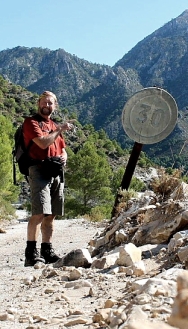
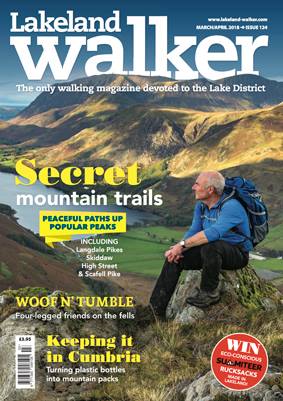




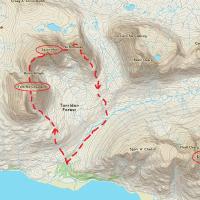
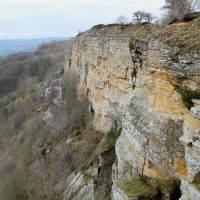

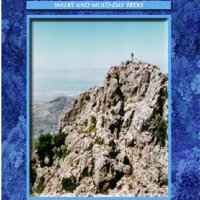





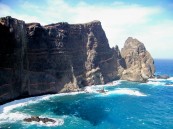

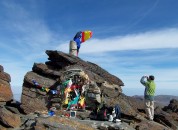



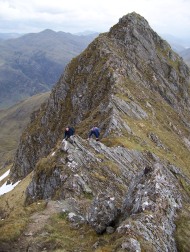
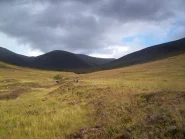




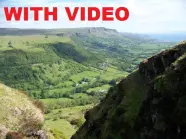
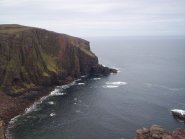
Another excellent story Alen. Your blog is a great discovery – I’ll be back to explore it further!
LikeLike
Hi Andy. You will note that I shied away from climbing Caballo from your starting point at Lanjaron and drove halfway up the mountain instead. I think if I’d set out from Lanjaron I’d be still up there yet!
Cheers, Alen
LikeLike
Wonderful…I wish I could be there 😊
LikeLike
There is snow on Cerro del Caballo this morning. It’s strange. Still warm enough for shorts and T-shirt here, but there’s snow on the tops.
Cheers, Alen
LikeLiked by 1 person